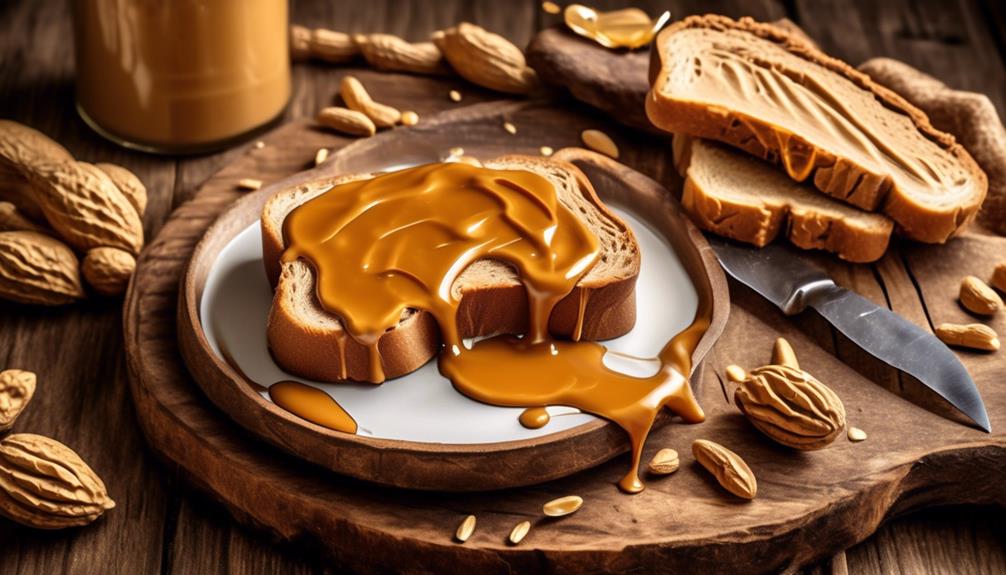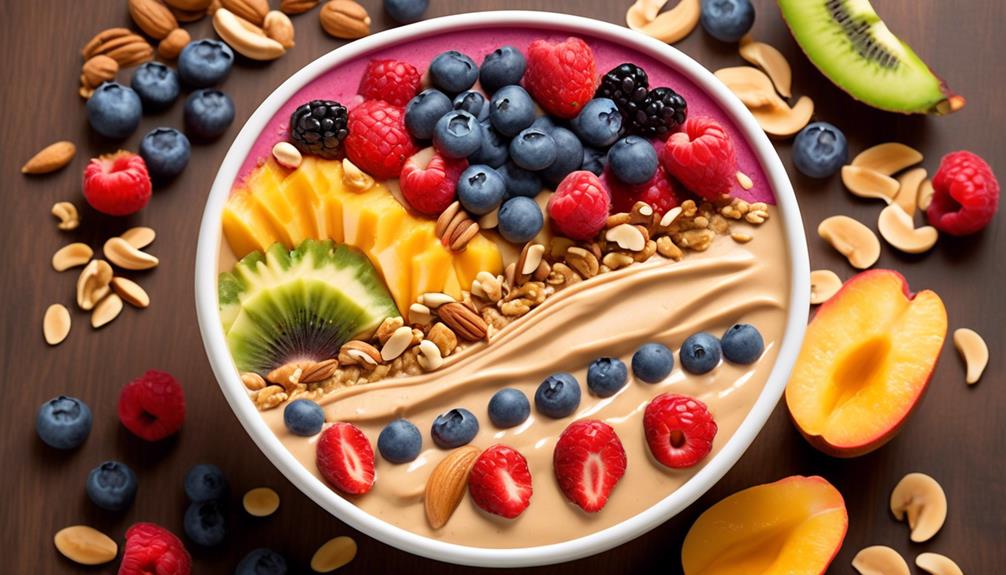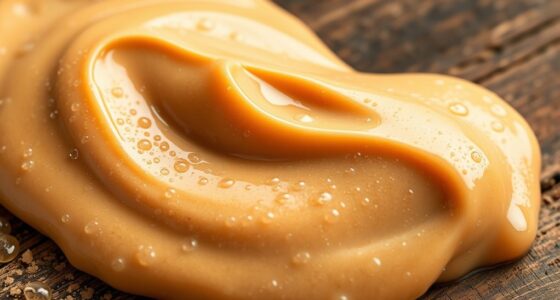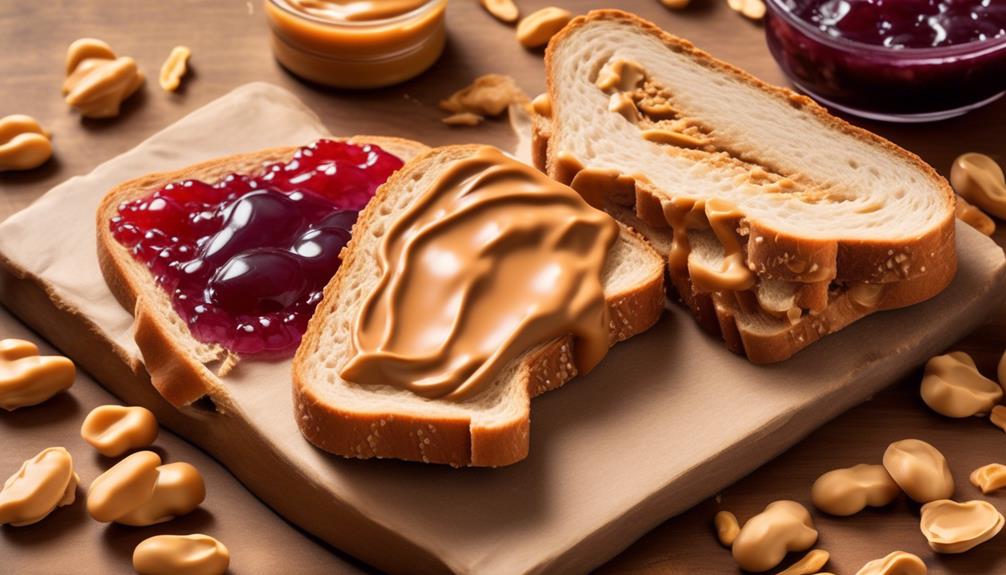Have you ever wondered why peanut butter holds such a special place in our hearts and pantries?
It's not just a matter of taste, but rather a culmination of factors that contribute to its undeniable allure. From its nutritional benefits to its satisfying texture, there's a lot to unpack when it comes to understanding why peanut butter is so good.
So, let's explore the various dimensions that make this humble spread a timeless favorite, and perhaps uncover some surprising reasons along the way.
Key Takeaways
- Peanut butter is a rich source of protein, healthy fats, vitamins, and minerals, making it beneficial for overall body function and health.
- Its flavor profile is characterized by a rich, nutty taste with a balance of sweetness and saltiness, making it suitable for a wide range of culinary applications.
- Peanut butter can be used in various ways, including as a spread, in smoothies, sauces, dressings, and baking, offering versatility in recipes.
- The creamy and rich texture of peanut butter enhances the overall taste and provides a satisfying and indulgent mouthfeel.
Nutritional Benefits
Peanut butter provides a rich source of protein, essential for muscle and tissue repair, hormone production, and overall body function. This makes it a valuable addition to a balanced diet. The protein content in peanut butter is particularly beneficial for individuals looking to support muscle growth and recovery after physical activity.
Additionally, the healthy fats present in peanut butter contribute to heart health and protect against oxidative stress, thanks to essential fatty acids and antioxidants. These nutrients play a crucial role in promoting overall health and well-being.
Furthermore, the vitamins and minerals found in peanut butter, such as vitamin E, magnesium, and potassium, offer additional support for bodily functions. The inclusion of dietary fiber in peanut butter also aids in digestion, promotes a feeling of fullness, and supports weight management.
Altogether, the nutritional profile of peanut butter makes it a compelling choice for individuals seeking a healthful and balanced diet. Its combination of protein, healthy fats, vitamins, minerals, and fiber contributes to its overall positive impact on health and well-being.
Flavor Profile

With its rich, nutty flavor and creamy, smooth texture, peanut butter offers a balanced combination of sweetness and saltiness, creating a highly satisfying taste experience. The flavor profile of peanut butter is multi-dimensional, with roasted and earthy undertones that contribute to its distinct taste. This beloved spread also boasts a nutty and slightly roasted aroma, enhancing the overall sensory experience.
The versatility of its flavor profile makes peanut butter suitable for a wide range of culinary applications, from sweet treats like cookies and smoothies to savory dishes like satay sauces and peanut dressings. Additionally, the balance of sweetness and saltiness in peanut butter makes it a perfect complement to various ingredients, elevating the overall flavor of recipes.
Furthermore, the flavor profile of peanut butter isn't only delightful but also nutritionally beneficial. In addition to its satisfying taste, peanut butter is a good source of protein, making it a valuable addition to the diet. The combination of its delectable flavor and nutritional value makes peanut butter a versatile and popular choice for consumers seeking both taste and health benefits.
Versatile Usage

When considering the versatile usage of peanut butter, it becomes evident that this popular spread offers a multitude of culinary applications for enhancing both flavor and nutritional value.
Peanut butter can be used as a spread on bread, crackers, or fruits for a quick and versatile snack.
It can be incorporated into smoothies, oatmeal, or yogurt for added flavor and protein.
Peanut butter can be used as a base for sauces, dressings, and marinades to add depth and creaminess to dishes.
It can be included in baking recipes such as cookies, brownies, and energy bars for a rich and nutty flavor.
Additionally, peanut butter can also be used in savory dishes like stir-fries, satay sauces, and noodle dishes for a unique and delicious twist.
The versatility of peanut butter allows for a wide range of culinary creativity, making it a staple in many kitchens.
Its ability to enhance both sweet and savory dishes makes it an indispensable ingredient.
Whether it's used as a spread, a baking ingredient, or a flavor enhancer in cooking, peanut butter adds a delightful nuttiness and richness to any dish.
Satisfying Texture

When it comes to peanut butter, its satisfying texture plays a crucial role in its appeal.
The creamy and rich consistency of peanut butter provides a mouthwatering experience that's smooth and delightful.
This unique texture is one of the key factors that contribute to the overall enjoyment of peanut butter.
Creamy and Rich
Creamy and rich peanut butter offers a luxurious and indulgent eating experience, with its smooth texture melting smoothly in the mouth and enhancing the overall taste and enjoyment when spread on bread, crackers, or fruits.
When you take a bite of creamy peanut butter, it's as if a wave of velvety richness washes over your taste buds, creating a comforting and satisfying sensation. The indulgent creaminess of peanut butter adds a touch of decadence to your snacks and meals, making every bite a delightful experience.
The smooth and rich texture of creamy peanut butter provides a comforting mouthfeel, leaving you feeling content and fulfilled. Its luscious consistency adds a layer of luxuriousness to every bite, elevating the overall enjoyment of this beloved spread.
- Indulgent and satisfying
- Comforting and fulfilling
- Decadent and delightful
- Luxurious mouthfeel
- Enhances overall enjoyment
Mouthwatering and Smooth
The luscious and satisfying texture of peanut butter not only evokes a sense of indulgence but also contributes to its overall mouthwatering appeal, making it a beloved spread for many. When examining the texture of peanut butter, it's clear that its smoothness plays a pivotal role in its allure. The creamy, velvety consistency creates a delightful sensation on the palate, enhancing the overall sensory experience. This mouth-coating richness is achieved through the high levels of natural oils present in peanuts, resulting in a luxurious, silky texture that is undeniably satisfying. Below is a table summarizing the key factors contributing to the mouthwatering and smooth texture of peanut butter:
| Factors | Description |
|---|---|
| Natural Oils | High levels contributing to smoothness |
| Ground Consistency | Finely ground peanuts for creaminess |
| Emulsifiers | Enhancing the spreadability |
| Creaminess | Providing a satisfying mouthfeel |
Psychological Comfort

Understanding the significance of psychological comfort is essential in promoting emotional resilience and mental well-being. Psychological comfort encompasses the feeling of security, ease, and contentment that individuals experience in their surroundings and interactions. It's influenced by familiar environments, supportive relationships, and a sense of control over one's circumstances. The role of psychological comfort in mental well-being can't be overstated. It contributes to reduced stress and anxiety levels, fostering a sense of overall emotional resilience.
Strategies to enhance psychological comfort may include creating a calming physical space, fostering positive social connections, and practicing self-care and mindfulness techniques. Addressing psychological comfort is crucial in promoting mental health and well-being.
- Feeling secure and at peace in one's surroundings.
- Having supportive and nurturing relationships.
- Experiencing a sense of control over one's circumstances.
- Creating a calming physical space for relaxation and reflection.
- Engaging in self-care and mindfulness practices for emotional balance.
Peanut butter, with its creamy texture and rich flavor, has the potential to evoke feelings of comfort and warmth, contributing to a sense of psychological well-being. The familiarity and indulgence associated with peanut butter can provide a soothing effect, nurturing the heart and mind.
Culinary Pairings

Peanut butter's rich, nutty flavor makes it a perfect pairing with chocolate, creating a classic and indulgent combination.
Its versatility in recipes allows it to be incorporated into both sweet and savory dishes, adding depth and creaminess.
Additionally, peanut butter's natural sweetness enhances the flavors of various fruits, making it a popular choice for fruit-based snacks and desserts.
Perfect With Chocolate
Pairing peanut butter with chocolate creates a delectable combination that's beloved by many. The rich, nutty flavor of peanut butter perfectly complements the smooth, decadent taste of chocolate, resulting in a culinary match made in heaven. When these two ingredients come together, they create a sensory experience that tantalizes the taste buds and evokes feelings of comfort and indulgence.
The creamy texture of peanut butter intertwines with the velvety sweetness of chocolate, creating a symphony of flavors that's simply irresistible.
- The contrast of creamy peanut butter against the rich, bold flavor of dark chocolate creates a harmonious balance.
- The combination of salty peanut butter with sweet milk chocolate elicits feelings of nostalgia and satisfaction.
- The smooth, nutty notes of peanut butter seamlessly meld with the luscious, cocoa-infused essence of chocolate, resulting in a luxurious treat.
- The marriage of peanut butter and chocolate triggers a pleasurable sensation that's both comforting and euphoric.
- The union of peanut butter and chocolate is a timeless classic that never fails to delight the senses.
Versatile in Recipes
When exploring culinary pairings, it becomes evident that peanut butter's versatility in recipes extends across a wide spectrum of flavors and dishes. From savory stir-fries to sweet desserts, peanut butter proves to be a flexible ingredient. It pairs seamlessly with fruits like apples and bananas, complements the richness of chocolate, and enhances the flavors of savory dishes such as satay or curries. The addition of peanut butter brings a delightful richness, creaminess, and nutty flavor to recipes, making it a valuable asset in both cooking and baking. Whether it's used as a topping for toast, blended into salad dressings, or incorporated into marinades, peanut butter adds a unique and delicious flavor to a wide range of culinary creations.
| Culinary Pairing | Description |
|---|---|
| Fruits | Pairs well with apples, bananas, and berries for a delightful twist |
| Chocolate | Complements the richness of chocolate in various desserts |
| Savory Dishes | Enhances the flavors of savory dishes like satay and curries |
| Baking | Adds richness and nutty flavor to a variety of baked goods |
Enhances Fruit Flavors
Enhancing the natural sweetness and texture of fruits, peanut butter provides a versatile and flavorful addition to a wide range of fruit-based dishes and desserts. When combined with peanut butter, the tartness of berries is balanced, creating a delicious contrast of flavors and textures.
The creamy consistency of peanut butter complements the juiciness of peaches and pears, elevating their taste and adding a satisfying element to the dish. Peanut butter pairs well with bananas, apples, and strawberries, enhancing their natural sweetness and adding a rich, creamy texture.
Incorporating peanut butter in fruit-based desserts like tarts or pies not only enriches the flavor but also adds a delightful nuttiness to the overall taste profile.
Adding a dollop of peanut butter to a fruit smoothie not only enhances its flavor but also provides a protein boost, making it a more satisfying snack or meal replacement.
Health Considerations

Considering the nutritional profile of peanut butter, its inclusion in a well-rounded diet can offer valuable health benefits. Peanut butter is good for providing a rich source of protein, healthy fats, vitamins, and minerals.
The fiber and protein content in peanut butter may aid in reducing overall calorie intake and supporting weight management by promoting a feeling of fullness and controlling appetite. However, it's important to be mindful of the high amounts of sugar and saturated fat in peanut butter, as excessive consumption can contribute to weight gain, obesity, and potential health problems. Moderation is key when incorporating peanut butter into one's diet.
Additionally, individuals with peanut allergies should exercise caution and opt for alternatives, while those concerned about aflatoxin contamination should choose commercial brands closely monitored for aflatoxin levels. It's also crucial to select natural or organic peanut butter with minimal added ingredients, practice portion control, and consider individual health conditions and dietary preferences.
Historical Significance

The historical significance of peanut butter can be traced back to its introduction at the 1904 World's Fair in St. Louis, where it gained widespread attention and popularity as a nutritious, versatile food product. This event marked the beginning of peanut butter's journey to becoming a beloved staple in the United States and beyond.
Peanut butter's emergence at the World's Fair symbolizes the intersection of food, culture, and innovation, reflecting the dynamic nature of culinary history.
Its adoption into American households mirrors the evolution of dietary habits and the incorporation of new and diverse ingredients into everyday cuisine, shaping the nation's culinary identity.
The widespread embrace of peanut butter showcases the power of food to transcend geographical and cultural boundaries, uniting people through a shared appreciation for its delectable taste and nourishing qualities.
The integration of peanut butter into various recipes and culinary traditions exemplifies its ability to inspire creativity and adaptability, enriching culinary experiences and traditions.
The enduring legacy of peanut butter underscores its enduring appeal and its enduring position as a cherished comfort food, evoking nostalgia and fond memories for many.
Cultural Significance

Peanut butter's cultural significance is rooted in its historical ties, culinary adaptability, and emotional resonance.
Its presence in the American diet reflects its enduring legacy, serving as a symbol of comfort and nostalgia for many.
Additionally, the diverse ways in which peanut butter is utilized in different cultural traditions and culinary practices underscores its widespread influence and significance in various societies.
Historical Roots
How has the cultural significance of peanut butter evolved over time and across different culinary traditions?
Peanut butter has a rich historical heritage, dating back to the ancient Incas and Aztecs who first ground roasted peanuts into a paste. Its popularity surged in the United States during the early 20th century, becoming a staple due to its affordability and high nutritional value, especially during the World Wars. Commercial production by companies like Kellogg and Heinz further solidified its presence.
The cultural significance of peanut butter is evident in its association with American childhood nostalgia, often found in classic school lunches and snacks. Additionally, in African and Asian cuisines, peanut butter has long been utilized in savory dishes, displaying its adaptability across diverse culinary traditions.
These historical roots showcase the enduring appeal and versatility of peanut butter as a good and healthy food.
- Nostalgic association with childhood lunches
- Cultural adaptation in diverse cuisines
- Affordability and high nutritional value
- Long-standing presence in American culinary traditions
- Enduring popularity and versatility
Culinary Versatility
Having explored the historical roots of peanut butter and its cultural significance, it is now important to examine its culinary versatility and the impact it has had on various cuisines worldwide. Peanut butter's rich, creamy texture and nutty flavor make it a versatile ingredient in both sweet and savory dishes. Its ability to enhance the taste and texture of a wide range of recipes has earned it a special place in the culinary world. Below is a table showcasing the culinary versatility of peanut butter in various cuisines:
| Cuisine | Dish | Use of Peanut Butter |
|---|---|---|
| American | Peanut Butter Cookies | Main ingredient |
| Asian | Thai Peanut Sauce | Key flavor component |
| African | Peanut Stew | Thickener and flavor enhancer |
Peanut butter's ability to add depth and richness to dishes has made it a beloved ingredient across cultures, contributing to its status as a culinary staple.
Emotional Connection
Why does peanut butter hold such deep emotional connections for many people, transcending cultural boundaries and becoming a symbol of comfort and nostalgia?
Peanut butter's emotional connection is deeply rooted in its association with childhood comfort and nostalgia, making it a staple in many households and a symbol of simple, wholesome living. Its presence in popular culture as a metaphor for familiarity and reliability further solidifies its emotional significance. Additionally, its role as a comfort food during times of stress or sadness enhances its emotional connection. Cultural traditions and celebrations also contribute to its emotional significance, such as peanut butter cookies for holidays or peanut butter sandwiches for picnics.
Production Process

The production process of peanut butter begins with the careful selection of high-quality peanuts, typically runner varieties, renowned for their rich flavor and high oleic acid content. Subsequently, the selected peanuts undergo cleaning to remove impurities and are then roasted to elicit the characteristic roasted peanut flavor through the Maillard reaction. Once roasted, the peanuts are cooled, and their skins are removed before being ground into a smooth paste using industrial equipment. Additional ingredients such as salt, sweeteners, and stabilizers may be added to create various peanut butter variations, tailored to specific taste and texture preferences. Finally, the peanut butter is packaged into jars or other containers, ready for distribution and consumption.
| Production Process Steps | Details |
|---|---|
| Selection of Peanuts | High-quality runner peanuts chosen for flavor and oleic acid content |
| Cleaning and Roasting | Peanuts cleaned and roasted for Maillard reaction |
| Grinding and Addition of Ingredients | Peanuts ground into paste, additional ingredients added |
| Packaging | Peanut butter packaged for distribution and consumption |
This meticulous process ensures the creation of the creamy, flavorful peanut butter that many enjoy. Notably, the production process significantly impacts the nutritional content of peanut butter, with variations in grams of fat and other nutrients depending on the specific ingredients and production methods used.
Consumer Preferences

The meticulous production process of peanut butter significantly influences consumer preferences as they seek transparency and detailed information about the product they consume. When it comes to peanut butter, consumers are increasingly looking for brands that offer openness and responsiveness to their inquiries. This reflects the growing importance of open communication and customer engagement in shaping consumer choices.
Additionally, the shift in advertising preferences from traditional mediums like newspapers to social media and influencer marketing highlights the need for brands to adapt to new platforms for effective communication, showing the evolving nature of consumer behavior.
Consumers prefer brands that are transparent and responsive to inquiries, indicating the importance of open communication and customer engagement.
The shift in advertising preferences from traditional mediums like newspapers to social media and influencer marketing reflects changing consumer behavior and the need for brands to adapt to new platforms for effective communication.
Personal responsibility and character of a brand can influence consumer preferences, emphasizing the significance of ethical and accountable business practices in shaping consumer perception.
The consumer's quest for understanding product quality and taste highlights the increasing importance of seeking information from reputable sources and industry experts for informed decision making.
The nutritional composition, health benefits, and potential risks associated with a product, such as peanut butter, significantly influence consumer choices, underlining the impact of health-conscious preferences on purchasing decisions.
Understanding the nutritional composition, health benefits, and potential risks associated with a product, such as peanut butter, also significantly influences consumer choices. Consumers are increasingly concerned about aspects like added sugar content and grams of protein, showcasing the impact of health-conscious preferences on purchasing decisions.
Frequently Asked Questions
Why Is Peanut Butter so Delicious?
We find peanut butter delicious due to its creamy texture, rich, nutty flavor, and natural sweetness. The roasting process enhances its aromatic flavors, contributing to its deliciousness.
Its versatility allows it to be paired with a wide range of foods, adding depth and richness to dishes.
The high protein and healthy fat content not only contribute to its delicious taste but also provide a satisfying and nourishing snack option.
Why Do I Like Peanut Butter so Much?
We simply love peanut butter so much because of its irresistible combination of flavors and satisfying creamy texture. Its high protein and healthy fat content contribute to its deliciousness and satiating qualities.
The versatility of peanut butter as a spread, dip, or ingredient in both sweet and savory dishes makes it a popular and enjoyable food. Additionally, the nostalgic and emotional connections people have with peanut butter contribute to its strong appeal.
Is It OK to Have Peanut Butter Every Day?
Yes, it's okay to have peanut butter every day as part of a balanced diet. It provides protein, healthy fats, and fiber, supporting overall health.
However, it's important to choose natural or organic options without added sugars and oils, and practice portion control. Overconsumption may lead to weight gain, and those with peanut allergies should avoid it.
Moderation is key for reaping the nutritional benefits without negative effects.
Why Is Peanut Butter a Superfood?
Peanut butter is a superfood due to its rich protein content essential for muscle, bone, and blood health.
It's high in healthy fats, vitamins, and minerals, and a good source of dietary fiber and essential amino acids. Its fiber aids in weight management by controlling appetite and supporting a healthy metabolism.
It's a nutritious option, providing more protein and fewer additives than many processed spreads.
Conclusion
In conclusion, peanut butter's rich and creamy texture, combined with its nutty and slightly sweet flavor, makes it a versatile and satisfying choice for a snack or meal.
Its nutritional benefits, historical and cultural significance, and production process all contribute to its popularity and delicious taste.
As the old adage goes, 'good things come in small packages,' and peanut butter certainly proves this to be true with its packed nutrition and delightful flavor.










